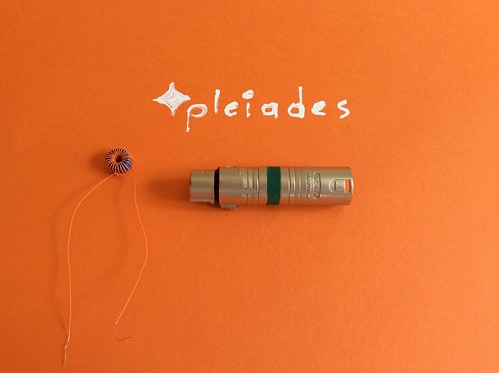
Pleiades in line passive microphone EQ, Filter.
The color on the Neutrik modules indicates the optimum mic to source distance for flat frequency response. (Directional microphones exhibit an increasingly large increase in bass the closer the microphone is to the source of sound).
Inside the Neutrik modules is an inductor connected to pins 2 and 3 (live, return) ie in parallel to the microphone signal. The number of turns (difference in external XLR adaptor color) in the internally housed toroidal core adjusts the turnover frequency with a slope of 6 dB per octave to equalize the
proximity effect and restore a flat frequency response for any source to microphone distance.
The 6dB per octave slope is produced by the output impedance of the microphone (usually 200 ohms) and the shunt inductance of the Pleiades EQ filter.
Most microphones may need a Pleiades filter, even omnidirectional ones.
The spectrum of our voice when we sing changes dramatically with how softly or loudly we sing. This is called the voice effort effect. Voice when soft was a tremendous increase in bass and high frequencies.
Additionally the frequency responce curve of our ear brain changes dramatically with sound intensity level. When something has a high intensity the sensitivity of our ear-brain increases dramatically in the low and high frequencies. These curves are called Fletcger Munson or equal loudness curves.
A screaming baby in danger miles away in a dessert emits a very high midrange only content and the ear-brain of a person miles away has greatest sensitivity in that region at such a low intensity level of the far away sound. So the baby can be heard and rescued.
When the level is different between the acoustical level of a singer recording and the intended end result in reproduction, as is almost always in pop music, we need to EQ.
The Pleiades filters further act as the simplest (almost straight wire) shelving filters when we deviate from the optimum chosen distance. When closer we have a bass shelving filter. When further we have a high frequency shelving filter.
All these effects together with playing with Pleiades EQs and different microphone distance may allow as to have flat frequency responce not from mic to loudspeaker but from the vocal chords of the singer to the brain of the listener.
Reference: Sound picture recording and reproducing characteristics - D. P. Loye and K. F. Morgan - J.S.M.P.E (Journal of Society of Motion a Pictures Engineers, presented at the 1939 Spring Meeting in Hollywood, Calif; received April 17, 1939)
No comments:
Post a Comment